1963 Cheoy Lee 36
$41,900.
The story of "Flying Buffalo" (Cheoy Lee Offshore 36 #1) is a great story about the infancy of our great sport, and the accomplishment of another member of the "Great Generation". Please go to Brokers Notes in the listing for full details.

Specifications
Additional info, basic boat info.
Flying Buffalo and the Cheoy Lee Offshore 36 was what happened when a member of our Great Generation decides to do something, THEY DID IT! Flying Buffalo came to life because a succesful Detroit area, sailor, auto industry engineer decided he wanted a bigger faster boat then the class boat of the day, the Pilot. He started out by making 3' models of both hulls and water tested them with a makeshift towing rig that would get them up to speed and release them. The Flying Buffalo prototype would always coast out in front of the other model proving it speed potential. As they say necessity is the mother of invention! Built with the help of family and friends over a 3 years, in a friends garage the boat was launched in 1962. It quickly became the boat to beat and the boat that attracted the best of the best in local sailing. It's design was sold to Cheoy Lee Yachts and was manufactured as the Offshore 36 for the next 10 year, with a 1000 hulls being sold. Not bad for a homemade effort!!!
The prototype "Flying Buffalo" has been well traveled, from another Detroit area sailor that took a bunch more flags, to Florida only and surviving a hurricane, and eventually to a North East coast owner that did the first major rebuild. The two sons decided to buy it and bring it home for another major refit and a few more flags along the way. The list is impressive, all new Harken hardware, new electronics, new teak deck, new motor, and an off the charts sail inventory (one son is a long time sailmaker). Now you get to own a bit of yachting history, that is an absolute "Wolf in Sheep's Clothing".
- New Main Bulkheads
- New Teak Decks
- New Main Hatch
- Bottom Long Boarded, Faired, and Sealed
- New Harken Adjustable Genoa Leads
- New Harken Traveler
- 4 New Harken St Winches
- All New Deck Hardware
- New Bata Marine Diesel Motor
- New Electrical Wiring
- New Plumbing New Head and Holding Tank
- New Galley and Hanging Locker
- Mast Sanded, Stained, and Varnished
- All new blocks and Halyards
- New Forward Hatch
- New Dorade's
- Faired, Sealed, And Painted Topsides
- New Rudder Bearings
- New Instruments
- Updated Interior Paint and Varnish
- New Port Side Cabin Storage Bins.
- New Bow Pulpit
- New Cushions
- Complete Restoration of Exterior Varnish
- Interior Painting and Varnish Updates
- As I Said Off The Charts!!!
- The Entire Inventory is Like New
- 2017 North 3Di Main
- 2015 Doyle Main
- 2015 Lt #1 Med Doyle
- 2017 Lt/Med #1 North
- 2015 Lt #1 Doyle
- 2015 Hvy #1 Doyle
- 2015 #2 Doyle
- 2015 Storm Jib Doyle
- 2015 Spin Staysail Doyle
- 2018 Genoa Staysail Sobstad
- 2018 A-1.5 Doyle
- 2017 S-2 North
- 2015 S-4 Doyle
- 2015 A-3 Doyle
- 2015 Code Zero Doyle
- 2018 Tweener Doyle
- Back-up Sails
- #3 Doyle 2015
- A-1.5 Doyle 2015
- S-2 Doyle 2015
- Dacron Main
- Dacron Genoa
- Safety Equipment
- All USCG Required Equipment
- All Mackinac Race Safety Gear
- Additional Equipment
- Navtec Backstay Adj
- Harken Furler
- Carbon Spin Pole
- All New Spinlocks P & S
- All Selftailing Winches
- New Garmin Electronics
- 20/20 Garmin Displays Forward
- Garmin 547 GPS Plotter
- Std Horizon VHF
- All New Blue Seas Electrical System
- 20 AMP Battery Charger
- Original Record
- Bayview Mackinac 1964, 1967, 1968
- Chicago Mackinac Overall 1966, 1968
- Mills Race Overall 1966, 1967, 1968
- Modern Record
- Bayview Mackinac 2015 1st in Class and Overall
- Chicago Mackinac 2016, 2017 1st in Class 1st and 2nd Overall
- Bayview Mackinac 2018 1st in Class 1st Overall
- North Channel Race 2018 1ST in Class 1 Overall
- Request Info
Contact Form Submission
Send request.
We have placed cookies on your device to help make this website better.
You can use this tool to change your cookie settings. Otherwise, we’ll assume you’re OK to continue.
Some of the cookies we use opens in a new tab/window are essential for the site to work.
We also use some non-essential cookies to collect information for making reports and to help us improve the site. The cookies collect information in an anonymous form.
To control third party cookies, you can also adjust your browser settings opens in a new tab/window .
- New Sailboats
- Sailboats 21-30ft
- Sailboats 31-35ft
- Sailboats 36-40ft
- Sailboats Over 40ft
- Sailboats Under 21feet
- used_sailboats
- Apps and Computer Programs
- Communications
- Fishfinders
- Handheld Electronics
- Plotters MFDS Rradar
- Wind, Speed & Depth Instruments
- Anchoring Mooring
- Running Rigging
- Sails Canvas
- Standing Rigging
- Diesel Engines
- Off Grid Energy
- Cleaning Waxing
- DIY Projects
- Repair, Tools & Materials
- Spare Parts
- Tools & Gadgets
- Cabin Comfort
- Ventilation
- Footwear Apparel
- Foul Weather Gear
- Mailport & PS Advisor
- Inside Practical Sailor Blog
- Activate My Web Access
- Reset Password
- Customer Service

- Free Newsletter

Bristol Channel Cutter 28: Circumnavigator’s Choice
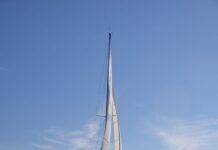
Hunter 35.5 Legend Used Boat Review

Pearson Rhodes 41/Rhodes Bounty II Used Sailboat Review
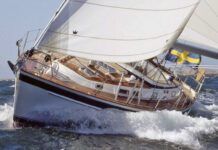
Hallberg-Rassy 42 Used Sailboat Review

Best Crimpers and Strippers for Fixing Marine Electrical Connectors

Thinking Through a Solar Power Installation

How Does the Gulf Stream Influence our Weather?

Can You Run a Marine Air-Conditioner on Battery Power?

Practical Sailor Classic: The Load on Your Rode

Anchor Rodes for Smaller Sailboats

Ground Tackle Inspection Tips

Shoe Goo II Excels for Quick Sail Repairs

Solutions for a Stinky Holding Tank

Diesel Performance Additives

What Oil Analysis Reveals About Your Engine

Hidden Maintenance Problems: Part 3 – Gremlins in the Electrics
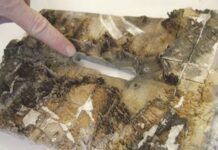
Seepage or Flooding? How To Keep Water Out of the Boat

Painting a New Bootstripe Like a Pro

Alcohol Stoves— Swan Song or Rebirth?

Living Aboard with an Alcohol Stove

Choosing the Right Fuel for Your Alcohol Stove

Preparing Yourself for Solo Sailing

How to Select Crew for a Passage or Delivery

Preparing A Boat to Sail Solo

Re-sealing the Seams on Waterproof Fabrics

Waxing and Polishing Your Boat

Reducing Engine Room Noise


Tricks and Tips to Forming Do-it-yourself Rigging Terminals

Marine Toilet Maintenance Tips

Learning to Live with Plastic Boat Bits
- Sailboat Reviews
Cheoy Lee Clipper 36 & 42
These golden oldies from bill luders remain popular classics..
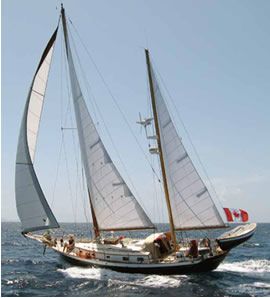
Cheoy Lee Shipyards of Hong Kong has been a commercial builder since the early 1900s and is one of the first molders of fiberglass boats in Asia. Production of fiberglass boats began in the early 1960s and continues today, although the company-like many big yards around the world-has turned its focus toward commercial ships and the mega-yacht market. Looking at the line of 78- to 100-plus-foot yachts catering to Far East millionaires and billionaires, it is clear that any concerns about what would happen to Cheoy Lee when Hong Kong reverted to China were way off target.
Main offices of the venerable shipyard, which was building commercial craft for many years before the advent of fiberglass, are located on the Kowloon waterfront. As their operation grew, the company moved much of the actual construction facilities out to Lantao Island. Its a barren place, virtually no trees, covered mostly with a brown grass. Workers are transported to and from each day by high-speed crew boats. Hydrofoil passenger boats are popular in the harbor, owing no doubt to the British.
Cheoy Lee, like many Asian builders as well as custom U.S. and European builders, makes many of its own parts. We will never forget walking into one of the sheds on Lantao Island to find, at the edge of the shadow and door light, an old man delicately fairing a sand-casting for a propeller. He used simple hand tools, working, as best we could tell, entirely by eye. Though Asian boats still carry a fair amount of locally made stainless and bronze hardware, this trend began to change during the 1980s, when Western buyers, wary of cheap Asian knock-off accessories, began to demand name-brand portlights, water pumps, and the like.
An improved standard of living in Hong Kong and Taiwan raised labor rates to the point that it made sense to import essential hardware rather than hand-tool, and the elaborate woodwork you find in the early Cheoy Lees is no longer available at bargain rates in Asia. Back in the late 1960s and 1970s, however, Cheoy Lee enjoyed an enviable reputation for classic design and superior workmanship, even if some of the boats suffered from a few problems endemic to Asia, such as inappropriate use of plywood, poor electrical wiring practices, and the endemic teak-deck leaks that earned them the name leaky teakies.
The Cheoy Lee Clipper 36 was built from 1969 to about 1988. The Clipper 42 was introduced in 1970. Eventually, both were replaced by the more contemporary designs of David Pedrick. We doubt that very many Clipper series boats were brought into the U.S. after the mid- or late 1980s.
A.E. Bill Luders Jr. drew the lines for quite a few early Cheoy Lees, including the Clipper series and many of the Midshipman (early center-cockpit boats) and Offshore series. The Clipper 33, 36, and 42 were popular in large part because of their classic lines. In ways, they are reminiscent of L. Francis Herreshoffs Ticonderoga. They are mostly ketch-rigged (actually cutter ketches with a Yankee, staysail, main, and mizzen), with bow sprits, wooden spars, graceful sheerlines, and moderate overhangs. Each has a full keel with attached rudder. Though we do not have all the drawings for the Clipper 36 and 42, their displacement/length ratios of 464 and 389 are very high, indicating that the garboards are quite slack and the bilges full. Or in other words, these are heavy-displacement boats with a very traditional Y-shape.
The numbers, however, are a bit deceiving because the sailing length will increase considerably as the boat heels.
The sail area/displacement ratio of the 36 ketch is 15.8, which is low to moderate. The 42 ketch has a more generous ratio of about 18. The divided sailplan is well suited to offshore cruising and will provide adequate power, especially on a reach. These boats would not be expected to excel either upwind or downwind. The 36 was available with a cutter rig, though we have no record of any in our files, and both the 36 and 42 could be ordered with a staysail schooner rig, of which we know at least a few.
The underwater lines of the 48, for which we have the full designer drawings, are similar to that of the 36 and 42. The Clipper 48 has a traditional interior with V-berth, pullout settees and pilot berths in the saloon, and an aft stateroom with double and single berths. Several alternative layouts were available, including a U-shape dinette in the saloon and a circular dinette forward.
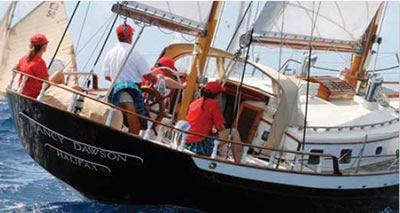
Photos courtesy of Susan Brown and Kieron O’Connell
Construction
Like most boats of this vintage, the Clipper 36 and 42 have solid fiberglass hulls. According to company literature, the thicknesses range from about 7/16-inch at the sheer to 1-inch at the keel. This is hefty. Unlike a number of other early fiberglass classics (such as the Mariner 31/32 or Black Watch 37), the Clippers had fiberglass decks, most with a teak overlay.
Henry Geerken, the owner of a 1969 model, told us that his deck was mahogany planking covered with fiberglass, then teak. He discovered this when he was having the deck planking removed. (As we have noted many times in previous articles, teak decks do not last forever, maybe 25 years, and replacement is very costly. Geerken paid $14,000 for a new fiberglass deck, which he said was less expensive than teak. In hot weather, he also found, this made the boat cooler inside.) Ballast is cast iron, externally fitted to the keel. Lead is preferable as it is denser, softer, and not subject to the corrosion that iron is. Youll want to keep the iron keel coated with epoxy, with all the attendant prep work, including, but not limited to sand- or bead-blasting to remove all traces of corrosion.
A number of owners have complained about the gelcoat, which one owner said was never up to par. Another said he had to paint his topsides after just three years. Geerkens cored fiberglass rudder split, though the surveyor said it could be satisfactorily repaired by injecting epoxy resin.
Steering is cable-quadrant, and on some boats, there was no provision for an emergency rudder. Before taking an ocean passage, youd want to work out an emergency steering system.
The interior is all wood, and nicely done, which was the main reason for buying an Asian boat in the first place. An old brochure calls it a lavish teak interior. The owner of a 1981 model , however, said it was beautiful, but too much teak to varnish. In recent years, there has been a trend away from teak for just this reason. (Lower initial cost, lower weight, and brighter interiors are three other good reasons.)
Bulkheads are tabbed to the hull, which provides for a very strong structure. A 1994 survey of Geerkens 1969 Clipper 36 showed the bonds to be intact. Other owners, however, complained about bulkheads made of non-marine grade plywood that was susceptible to rot.
Berths were foam rubber, covered with vinyl; if they havent been replaced yet, they should be. Countertops were Formica; sinks were stainless steel. The original toilet was the Wilcox-Crittenden Imperial, and the last time we checked, you could still find parts for this popular, well-made toilet.
Ventilation is provided by a teak and Plexiglas skylight, forward hatch, four cowl vents (five on the 42), and two Dorades. Skylights are notorious leakers and will have to be recaulked or rebuilt at some point. Although the original specs called for fixed ports, we have seen both fixed and opening ports on both models, usually high-quality bronze or stainless steel.
The interior, though not cramped, will seem small compared to more modern designs. The beam of the 36 is 10 feet, 9 inches, a nice figure for seakindliness. Comments from readers include, One should be fairly small in size to work on the engine as it is not easy to get into the compartment, and the interior is rather small due to the hull design. Another pined that the navigation area and head arent larger. An exception is the V-berth, which is commodious.
Fuel and water tanks are made of fiberglass. Aluminum is a better choice for diesel, and water in a fiberglass tank tends to taste a little funny. Still, if properly made, fiberglass certainly is serviceable. Geerkens surveyor did note that the copper fuel lines had unsupported runs, which could make them subject to vibration damage.
Geerken pointed out to us that the electrical system on his boat uses the positive as ground, which foiled his electrical trouble-shooting efforts until he figured it out.
Many original boats came with z wooden ladder that fit amidship, but these are often lost or deteriorate. Geerken bought an 8-foot one from Defender Industries.

Photo courtesy of Susan Brown
Performance
As mentioned earlier, the Clipper cutter-ketches or schooners sail best on a reach, and then their speed will be more than adequate. Upwind and downwind, the boat will feel slow compared to lighter, fin-keel sloops. But speed is not the reason to buy one of these boats. They are, after all, capable offshore designs.
Readers rate seaworthiness as excellent, but stability less so. As one would expect from the narrow beam, Y-shaped hull, and heavy Sitka spruce spars, they are a bit tender initially, though stiffen up nicely once their shoulders are in the water. One reader said, She looks after you.
Balance was rated as above average by most owners. With the ketch rig, it should be possible to get the boat to steer itself with the wind on the beam or forward of it. One owner said, it has slight weather helm. Trim sails, put wheel lock on, and lets go! Some weather helm, of course, is desirable and necessary.
Geerkens sail trim advice is to trim the Yankee first, staysail second, and main third; then ease the weather helm with the mizzen.
The main has roller-reefing rather than the jiffy reefing most often seen today. Roller reefing can work well up to about the first reef point, but it is unnecessarily complicated and can chafe the sails, so it makes sense to give up on this antiquated system and convert to simpler, more effective jiffy reefing.
Owner reports in our files indicate that the Clipper 36 was powered by either the Westerbeke 4-107 or Perkins 4-108, though some others we know had Atomic 4s. Both the Westerbeke and Perkins are excellent engines, but we prefer the Perkins. Owners of both said the engines were highly reliable, as we know from firsthand experience, but that accessibility is abominable, or in the words of one owner, zilch! Among other things, checking/adjusting the stuffing box will not be easy.
Expect to make about six knots at 1600 rpm. Literature from Lion Yachts, the old East Coast distributor, indicates that the 42 came with the Perkins 4-108, though one owner had a 75-horsepower Volvo diesel. Had 13 reasons for replacing after six years, he wrote. He repowered with a Perkins 4-108, which he said wasnt big enough, although many owners find it quite enough.
Full-keel boats with attached rudders and the propeller in an aperture do not tend to back down well, and the Clipper series is no exception.
Theres no denying that the classic look of the Cheoy Lee Clipper series is enough to make your heart flutter: Thats what a boat is suppose to look like! Indeed, some well-known personalities such as singer-songwriter Jimmy Buffet have succumbed to the Clippers Siren song. Construction certainly was above average, with heavily laid hulls and fairly sound joinery.
Less noticeable are a small variety of potential problems stemming from the wooden spars, occasional flaws in metal work, and electrical work and components. One Clipper owner, for example, found that the stainless chainplates were secured with iron bolts and nuts, which corroded. Lazarette, hatch, and seat locker lids were sometimes made of plywood with insufficient fiberglassover to seal out moisture. Previous owners may have upgraded or fixed some of these problems as they occurred. As with any boat, wed ask the most persnickety surveyor to go over it with a fine-tooth comb. Because the interiors of these boats are quite complex, we suspect the list of repair jobs will be longer than usual. Regarding performance, the boat is deceptively quick on a reach, but due to its full keel and heavy displacement hull shape, it does not excel upwind or down.
Prices for early models represent a good value in todays market. You might be able to pick up a 36 for less than $30,000, but carefully check the engine and teak decks as both are expensive to replace. You don’t buy a Cheoy Lee Clipper for performance or ease of maintenance. The 36 and 42 appeal to certain types of sailors, and you know who you are. Go in with your eyes open, ready to work (or pay), and youll have a boat to be proud of for many years to come.
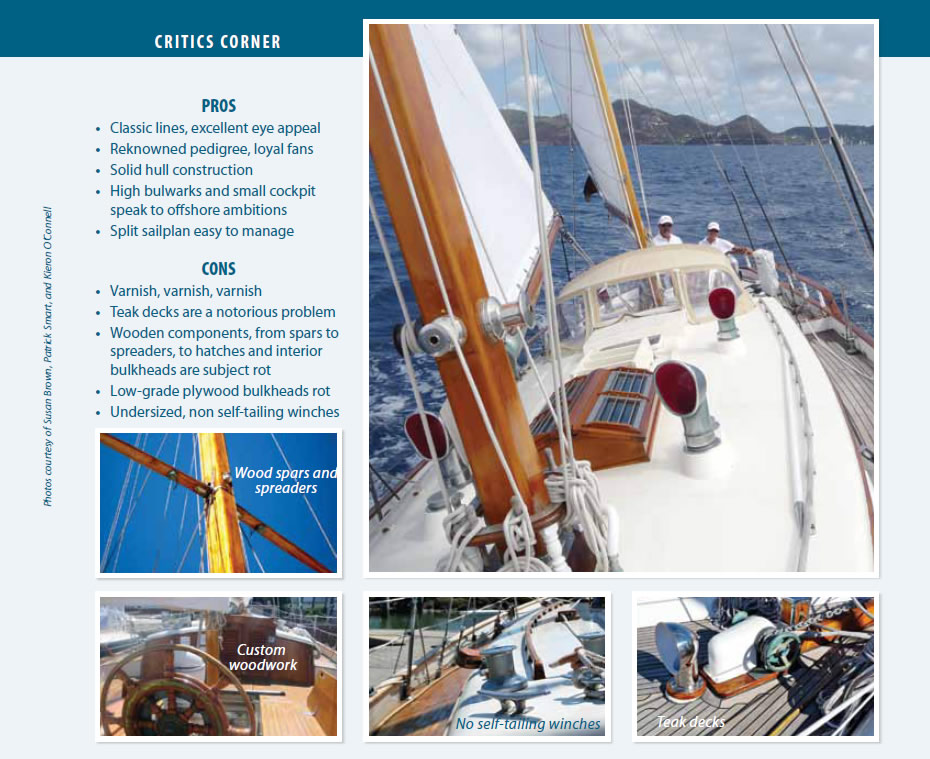
- Owners Say Beauty, Solid Hull Outweigh Clipper’s Flaws
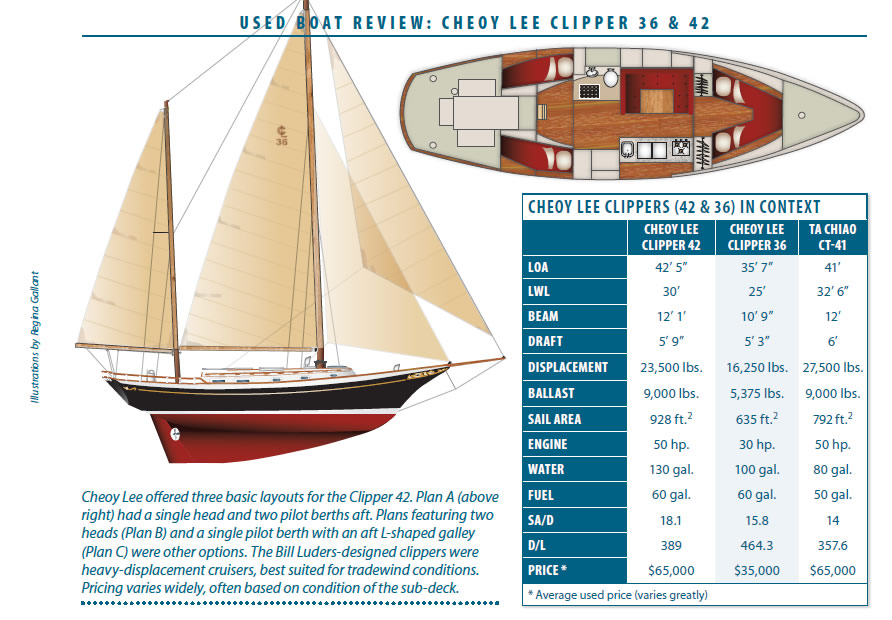
- Cheoy Lee Association
RELATED ARTICLES MORE FROM AUTHOR
Leave a reply cancel reply.
Log in to leave a comment
Latest Videos
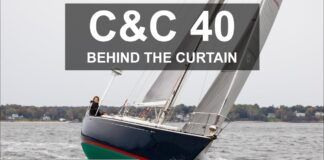
C&C 40: What You Should Know | Boat Review

A Simple Solution for Boat Toilet Stink

An Italian Go Fast Sailboat – The Viko S 35 |...

What Is The Best Folding Bike For Your Sailboat?
- Privacy Policy
- Do Not Sell My Personal Information
- Online Account Activation
- Privacy Manager
Great choice! Your favorites are temporarily saved for this session. Sign in to save them permanently, access them on any device, and receive relevant alerts.
- Sailboat Guide
Cheoy Lee Midshipman 36
Cheoy Lee Midshipman 36 is a 35 ′ 9 ″ / 10.9 m monohull sailboat designed by Alfred E. Luders and built by Cheoy Lee Shipyard starting in 1973.
Rig and Sails
Auxilary power, accomodations, calculations.
The theoretical maximum speed that a displacement hull can move efficiently through the water is determined by it's waterline length and displacement. It may be unable to reach this speed if the boat is underpowered or heavily loaded, though it may exceed this speed given enough power. Read more.
Classic hull speed formula:
Hull Speed = 1.34 x √LWL
Max Speed/Length ratio = 8.26 ÷ Displacement/Length ratio .311 Hull Speed = Max Speed/Length ratio x √LWL
Sail Area / Displacement Ratio
A measure of the power of the sails relative to the weight of the boat. The higher the number, the higher the performance, but the harder the boat will be to handle. This ratio is a "non-dimensional" value that facilitates comparisons between boats of different types and sizes. Read more.
SA/D = SA ÷ (D ÷ 64) 2/3
- SA : Sail area in square feet, derived by adding the mainsail area to 100% of the foretriangle area (the lateral area above the deck between the mast and the forestay).
- D : Displacement in pounds.
Ballast / Displacement Ratio
A measure of the stability of a boat's hull that suggests how well a monohull will stand up to its sails. The ballast displacement ratio indicates how much of the weight of a boat is placed for maximum stability against capsizing and is an indicator of stiffness and resistance to capsize.
Ballast / Displacement * 100
Displacement / Length Ratio
A measure of the weight of the boat relative to it's length at the waterline. The higher a boat’s D/L ratio, the more easily it will carry a load and the more comfortable its motion will be. The lower a boat's ratio is, the less power it takes to drive the boat to its nominal hull speed or beyond. Read more.
D/L = (D ÷ 2240) ÷ (0.01 x LWL)³
- D: Displacement of the boat in pounds.
- LWL: Waterline length in feet
Comfort Ratio
This ratio assess how quickly and abruptly a boat’s hull reacts to waves in a significant seaway, these being the elements of a boat’s motion most likely to cause seasickness. Read more.
Comfort ratio = D ÷ (.65 x (.7 LWL + .3 LOA) x Beam 1.33 )
- D: Displacement of the boat in pounds
- LOA: Length overall in feet
- Beam: Width of boat at the widest point in feet
Capsize Screening Formula
This formula attempts to indicate whether a given boat might be too wide and light to readily right itself after being overturned in extreme conditions. Read more.
CSV = Beam ÷ ³√(D / 64)
Available as sloop or ketch.
Embed this page on your own website by copying and pasting this code.
- About Sailboat Guide
©2024 Sea Time Tech, LLC
This site is protected by reCAPTCHA and the Google Privacy Policy and Terms of Service apply.

- Forum Listing
- Marketplace
- Advanced Search
- About The Boat
- Boat Builders Row
- SailNet is a forum community dedicated to Sailing enthusiasts. Come join the discussion about sailing, modifications, classifieds, troubleshooting, repairs, reviews, maintenance, and more!
Cheoy Lee Luder's 36
- Add to quote
Greetings All! It has been a few years since I tailed a wench, in most of the meanings you might take from that. It is time, again, to take to the water and I have just acquired a 36 foot 1974 Cheoy Lee, Luders design, sloop rigged. The boat is on the hard with mast and rigging down so I will take a couple of weeks to clean her up some, put on a fresh bottom, and maybe make the teak look a smidgeon better. The yard folks will step the mast at launching but to be honest, I will not know if it is done correctly or not. I don't want to make this boating season into a boat refitting period, the vessel will reveal herself and the needs will become obvious enough so I am receptive of advice on what things ought to take priority in outfitting for sailing in the general area north of Boston and the cape areas. Are there marinas or boat yards in the Gloucester area that allow DIYs to work on teak, varnish and such? The boat draws 5'3", where is a good place to base out of? What is the bottom paint of choice for sailors in this area? The Chesapeake is where I learned sailing, it is different around Rockport, MA. I have a lot to learn, open ears to hear and try to keep a good attitude. The engine is a Westerbeke W40, there is some other nomenclature, but it is about 37 hp with just under 1,500 hours. Any recommendations about maintaining the unit? As for doing varnish and teak work, does anyone have any ideas or admonishment about using paint strippers, solvents, or recommendations about sandpaper and places to get materials? I am only looking to do the hand rails on the cabin trunk, the teak trim around the trunk and some work on the cockpit area. It is pleasant to be excited about doing something again. The last time I sailed was about 1987. The years do slip away, 'eh? Bob in Rockport
Ludders 36 Hi Bob, We are in much the same position. A year ago last January we bought a Ludders 36 sloop. After getting hung up in the yard for most of the summer when small things became large things (mostly work on the Westerbeke) we were able to cruise for a couple of months at the end of the season and get a feel for the vessel. She is great under sail and comfortable at anchor. As you probably know the Cheoy Lee website is: ww.cheoyleeassociation.com While there are many Ludders 36 sloop owners registered, not many seem to participate at the site on a regular basis. We are bringing Callisto up to snuff one bit at a time. So far we: replaced the chain plates (they were a mess), put on new standing and some new running rigging with halyards lead internally installed a holding tank and new head. put on a roller furler have started to strip the teak with the plan being to use Armada finish. Armada is a compromise between varnish (don't have time for 8 to 12 coats) and oil (easy but minimal protection). We went the oil route on our last boat and never quite found the time to keep up with it during the season as it required. We are switching to a 3 blade prop this season. What kind of prop is in place on your vessel??? If 3 blade do you know the size and pitch? Good luck with your Ludders. Hope to hear good things about her from you. John and Marcia s/v Callisto
Luders CL36 Greetings John & Marcia, I may have seen some of your posts on the Delphi forum while grazing there this morning--yep, there seems to not be much interaction among owners but there are several lively web pages that celebrate various CL projects, Bisous, Invitation and related links from those pages as well. My prop is a three blade though I cannot tell you the pitch info yet. The boat is new to me and even simple stuff such as where to place the anode on the prop shaft is elusive. Given the very small amount of shaft exposed between the keel and the prop it seems likely that the zinc will have to attached to the end of the prop shaft. My first order of business is to prepare the bottom for paint and apply two coats of a general purpose product. The teak hand rails and the cabin sole or trunk or however the house part should be described needs a new finish as well but I am not going to be elaborate about it--prep the old surface, fill any stress cracks or crazing, mask, and roll & brush with Topsides or a similar product. The decks and gunwhale/toe rail were done in Cetol a couple of years back and have pretty much lost all of that finish so I will finish removing the rest with scraping or sanding as is most efficient. I am not committed to any particular product for refinishing the deck but the rails will get varnish as will the rest of the house trim and hatch covers, cockpit coamings cabin door. This boat has a roller furling rig that is serviceable but has seen a lot of service too. If I can keep it going for a year or two while researching and learning about options, all the better. The standing rigging is well placed on my list of upgrades and I will definitely provide an antenna system associated with the backstay when upgrading the rigging. I would also like to have second forestay for a short jib rather than using the roller furl rig for more wind than required for brisk sailing. Did you do anything with the fuel filtering system on yours? The Westerbeke in my rig has 1,468 hours on the meter so I expect another few hundred hours of service from it but feel a compelling urge to install some Racor inline filters that are more readily accessible than the original design. Where are you all sailing out of? Glad to hear from you and hope to hear from others as well, Bob Rockport, MA
Can anyone comment on the sailing characteristics of the Luders 36? Please let me know your comments on Luders 36 sailing characteristics. Thanks Bob A
I aquired a CL 36 and am trying to bring it out of a 7 yr retirement. How bad was it working on the chain plates?
Luders 36 My wife and I bought a Luders 36 in Maine a few weeks ago. It is stored under a shed in a marina on Isleboro, Maine. The boat is in need of bottom and topiside paint, brightwork, deck sanded to remove Cetol, and a good cleaning inside. She has been stored at least one year accordingly to the party we bought the boat from--confirmed by the marina owner. The Perkins 4-108 was rebuilt and has only 60 some hours on it. So that is a real positive. The windows will need to be removed and re-bedded. We are thinking of replacing the small lites with portlites, and I would be interested in hearing from any of you on this point. Is it something that you have done? Do you have any advice on this idea? The masts appear to be in good shape from what I could see of them up in the sail loft. The main mast is rigged with a "behind-the-mast" furling. I do not know how it will work out, as I have read lots about the pros and cons of these mainsail furling rigs. I am somewhat worried that the furling device may not be all that well fastened to the mast, for one thing. I have no way of knowing, of course, but I think the whole setup has inherent design weaknesses. But if I remove it, I am looking at getting a new or used mainsail to replace the cut-down mainsail required for this setup. The jib is also roller-furling rigged, which is OK I suppose, being a Harken. The boat also has a small woodstove installed, which looks to be in good condition, as is the interior woodwork. Our Cheoy Lee plaque bears the number 2893. I emailed CL in Hong Kong and they informed me the boat was completed in May of 1975 and was delivered to Lion Yacht in CT (still in operation, I later found out). I do not mean to bore all of you with these ramblings, but wanted to just share with you the project we have before us. Finally, we are excited about our CL Luders 36--despite my list of "issues" presented in this post. We look forward to beginning our work on the boat this spring and hope to try her out before summer's end.
re: CL 36 "issues" being boatstruck is euphoric! but seriously, you sound like you have a really nice boat. This is my first attempt to do work for myself, so reality sets in pretty quick. I tossed my calendar as a time line out last year. My only advice is if in doubt, find someone in the business you feel trustworthy and have them give you a second opinion to your own. I am fortunate as I rely on guys I have done bluewater sailing with on many occasions. I am still working on stripping the engine out and cleaning up the insides while I save $$ for a temp shelter. I need to replace the decks on my 69' CL. Everything else though is mostly cosmetics(not counting the engine) which is why I plug on with it. I really want to get her back in the water and let her run again. On my list, is bright work, new water and fuel tanks, bottom paint, repaint the interior and redo the cushions. As for the rigging, I am going to do a complete replacement on halyards and cables for piece of mind. I know it is going to take a bit, but I think it is worth it.
CL Luders 36 - Water Tanks Hi Yardbro, We are currently trying to decide what to do with our gross main water tank. It sits in the bilge down the center line of the boat. Inside is really quite gross, past the point of bleach and scrubbing. We trying to decide how to replace it without having to rip the thing out. What have you tried with yours? We're considering making a smaller stainless one to slide inside or like I said tearing it out and replacing properly. Sounds like a nightmare though! I hope you've had some luck with yours, any advice from you 36ers on here would be much appreciated! All the best Ryan & Becky Island Girl
Island Girl, If you don't do it now, then it will be later. I am in the middle of getting mine out too. It is very dirty right now too, but I am going to clean the area up as much as possible and replace the tank. Hopefully your screw heads are not all striped out. I use the Fast Orange hand cleanser and coveralls that stay outside till they become trash. Keep me posted on your progress and revelations. Cheers
We have not looked into our Ludders 36 yet--that will happen when we return to Maine in May. We will of course check out the water tank, among other items on and in Asturias. Good luck on your tank!
Just got a 72 Luder's 36 Sloop (plan A) .. inherited her after some idiot tied her off to a pier with a line around the primary port winch... which of course snapped the coaming board and also broke the winch support... new coaming boards all around are coming.... but anybody have any idea where I can get a new (vintage) Barlow winch support that matches the design? Also looking for any resource to find the original ship manuals and schematics... plumbing plans would be nice, huh? Sailing out of Narragansett Bay this summer.. planning a trip to Vinal Haven and Bar Harbor... love to connect with other owners!
So we now have the water tanks completed. After looking at all the options like tearing out the existing fiberglass and making a new stainless one, or just putting in a bladder we just decided the best and most cost effective thing would be to just paint it with a food safe paint. aquatapoxy I believe its called. Rated for the size of our tank and approved by the NSF. And the best part is it only cost around $100. Far cheaper than the other options! They are done now and look great. There is only the old fiberglass underneath which should have leached all its bad chemicals by now and new NSF approved paint on top.
I am wondering about the diameter of my rigging. I do not know the wrap/core count, but the stays appear to be 3/16" dia. I have a Luders 36 ketch, wood masts. I bought the boat a year ago, working on it now. Did not ask previous owner about the rigging and am now wondering if I should be using 1/4" dia.? Any thoughts?
Nsf What is NSF and where can i get info on the organization? thanks
The rigging on my boat is 1/4. Since I am planning on doing extensive offshore with the boat I called a rigger and had him come down to look over the boat with me. He said that the 1/4 wire would be fine, no point in going any larger. However I may go a size larger and get 5/16, just for that little extra boat upside down in a storm strength. The most important thing to remember is that the wire almost never fails it's usually always the fittings. All a larger wire really does is give you a stronger fitting. And about the NSF I guess this is one of those things that you need to say the whole thing otherwise it means something totally different. It's actually ANSI/NSF Standard 61. And the product is aqutapoxy. I think it may be the only one rated for 100 gallons or more. Most are for water tanks you can walk around inside of, definitely not mine.
Oh and it should be 1/19.
Hey Guys.. nice to see some new Cheoy Lee owners here. My vessel is the s/v Annelise - a 1972 Luder's 36 that I base in Narragansett Bay, RI. She has sailed from China to the South Seas to Mexico and San Fransico... trucked here a a few years ago looking Bristol and then was neglected. She has a brand new Yanmar3GM 40hp and new sails & rigging, refridgeration, diesel forced hot air, holding tank, hot and cold running water, shower, incredible workm drive Alpha autopilot, windlass and more. Love this boat... she's fast and solid as a rock on any heading. That being said, given that she was a no-holds barred beauty when she was built.. she HAD the good old Cheoy Lee Leaky Teaky Decks.... it's the kind of thing that makes you wonder how the Chinese ever surpassed us in the manufacturing world... 2 1/2" plank core in the deck with 50 zillion screws holding down the teak. ... needless to say, the dilapidated deck destroyed the value of the boat.. good for me in acquiring it, but a labor of love in owning here... I plan to do the Azores on this boat, so I am going through it thoroughly. I have pulled the teak decks off, repaierd the delamination we found on the Stbd sidewalk, laid a new layer of Divinicyl core and am 70% through laying an 1/8' "skin" to seal it in and paint with AwlGrip primer and non-skid. What a freakin experience. I am blessed to have the boat indoors in a shop for the last 7 months. I have photos of the job in progress here: Joseph Andrade's Photos - Boat Repair | Facebook and you can see a little movie of a trip I took with my daughter here: http://beta.marinemotion.com/stations/Sailing_with_Joe/Blog The website we're building uses HTML 5 so you need a newer broweser to view it ... it's also here: Joe Andrade Well. I am happy to share images, info, etc with ya'll and look forward to hearing from you.. we need to plan a raft up next season for all us New England folks, and that should get the group more involved in communicating. Looking forward to connecting with you .
jandrade said: Hey Guys.. nice to see some new Cheoy Lee owners here. My vessel is the s/v Annelise - a 1972 Luder's 36 that I base in Narragansett Bay, RI. She has sailed from China to the South Seas to Mexico and San Fransico... trucked here a a few years ago looking Bristol and then was neglected. She has a brand new Yanmar3GM 40hp and new sails & rigging, refridgeration, diesel forced hot air, holding tank, hot and cold running water, shower, incredible workm drive Alpha autopilot, windlass and more. Love this boat... she's fast and solid as a rock on any heading. That being said, given that she was a no-holds barred beauty when she was built.. she HAD the good old Cheoy Lee Leaky Teaky Decks.... it's the kind of thing that makes you wonder how the Chinese ever surpassed us in the manufacturing world... 2 1/2" plank core in the deck with 50 zillion screws holding down the teak. ... needless to say, the dilapidated deck destroyed the value of the boat.. good for me in acquiring it, but a labor of love in owning here... I plan to do the Azores on this boat, so I am going through it thoroughly. I have pulled the teak decks off, repaierd the delamination we found on the Stbd sidewalk, laid a new layer of Divinicyl core and am 70% through laying an 1/8' "skin" to seal it in and paint with AwlGrip primer and non-skid. What a freakin experience. I am blessed to have the boat indoors in a shop for the last 7 months. I have photos of the job in progress here: Joseph Andrade's Photos - Boat Repair | Facebook and you can see a little movie of a trip I took with my daughter here: http://beta.marinemotion.com/stations/Sailing_with_Joe/Blog The website we're building uses HTML 5 so you need a newer broweser to view it ... it's also here: Joe Andrade Well. I am happy to share images, info, etc with ya'll and look forward to hearing from you.. we need to plan a raft up next season for all us New England folks, and that should get the group more involved in communicating. Looking forward to connecting with you . Click to expand...
Hooray for Luders 36! Joe, Was the deck 2 1/2" the measurement from inner glass skin -> core -> outer glass skin -> teak planks? We're going to have to 'repair' our decks from the bow to the cockpit and we're researching our options. Go Luders! -chaz and emily
Oh.. the 2 1/2 " measurement was the width of the boards they used for core material. and teak or mahogany would be too oily for the resin to adhere to, so it's a material more like pine. they run the length of the deck between the fiberglas layers of the one piece trunk-cabin-deck molding. I you have to repair your decks .. i am assuming you have teak as well, you have to get to the deck below to fix any delamination issues, clean it up, and prep it for GLUEING down new teak.. nobody in their right mind puts 10,000,000 holes in a perfectly good deck anymore. Essentially, whatever you do, much of the process I just went through is probably part of what you need to do to rebuild your decks... I used a layer of core to create strength, bring the level of the deck back to where it was when the teak was new, and to make the deck impermeable to any water problems if a fitting leaks or a new hole is pierced in the skin. ( I also got a great insulation solution and with glass decks I can travel the tropics without burning my feet on the teak all the time... have you ever fried eggs on a teak deck beforeo? It CAN be done... and the artificial stuff is just as bad I hear). if you want to send me some pics of your decks I can give you some other feedback on what I see.. the critical element is: how old are they and how much teak is left to "fix". Quick update: only 10 square feet to go and all the core will be sealed in by at least the first layers of the top skin... hope to be priming and sanding end of the week.
Re: teak deck Was the old teak salvagable, or did you have to buy new stock? Are you relaying a sprung deck or straight? What glue are you using to fasten the deck with? We've put up a blog for our work on our boat here . -chaz and emily
chaaaaaaaz said: Was the old teak salvagable, or did you have to buy new stock? Are you relaying a sprung deck or straight? What glue are you using to fasten the deck with? We've put up a blog for our work on our boat here . -chaz and emily Click to expand...
Hey Chaz... saw your blog. nice... the old teak was not salvagable.. it was so thin in areas that it snapped easily.. it made for a nice pile of kindling in my fireplace last winter, though I didn't want to burn much there due to the glue still on the teak. Also, I have built a new glass deck on top of the old one and would never put teak down again. If you plan to sail anywhere hot, glass is so much easier on your feet, while also being so much easier to maintain. The deck I built has a core of Divinicyl Foam so my new glass deck is the same level as the old teak deck was, plus I have a truly great insulator for living aboard in cold months. Additionally, I ended up with very strong "double-decker" construction and will never have to worry about the old lower deck delaminating... I repaired all it's delam but if it it does behave badly the new deck takes all the load... and in the end, one can play tennis onboard and there is NO flexing or dipping on the new deck.. solid as she was designed to be. Most of the teak deck removals I see on these boats simply remove the teak, fill the holes and paint or gelcoat over... it leaves gaps and low spots, and in the end you're still relegated to the original deck. While more work, putting a layer of core material down and laying up a new surface essentially creates an optimal new deck. On the other hand, I've had the boat in the shop for 8 months... expect to finish the primer and fairing tomorrow and she's scheduled for a topsides, deck and cabin Awlgrip beginning of next month. So much for summer sailing in New England, but she's going to be sweet and really ready for next year. (Bermuda I hope! )
jandrade said: The deck I built has a core of Divinicyl Foam so my new glass deck is the same level as the old teak deck was, plus I have a truly great insulator for living aboard in cold months.) Click to expand...
sprung vs straight laid deck Yes, sprung as in the deck planks are bent to match the hull's curve fore and aft, as opposed to straight planks. But if you're glassing the deck, then it doesn't matter. :+) -chaz and emily
seeking Cheoy Lee Hatch Hinges Hey all... I am searching for a pair of replacement teak hatch hinges... cheoy lees being famous for their "open both directions" hatches means they have the little removable pins that one can swap over to the other set of hinges if you want. one set of mine lost the extensions for the pins ( previous owner must have had a windy day!) Any idea where I can get some replacements? IMAGE on Facebook
Jandrade, Did you ever find the replacement teak hatch hinges? I'm looking for the hinges and the pins. Also, those of you who have CL Luders 36's, where is the holding tank installed on your boat? Thanks all.
- ?
- 174.8K members
Top Contributors this Month
Posted 2024-06-01 17:40
Contact Information:
36' Cheoy Lee Sailboat - $34,000 (Kemah)

google map
QR Code Link to This Post
post id: 7752907685
posted: 2024-06-01 17:40
updated: 2024-06-03 14:09
♥ best of [ ? ]
refresh the page.
36' Cheoy Lee Sailboat - boats - by owner - marine sale - craigslist
Newly rebuilt Cheoy Lee sailboat with 6' draft and 11.5' beam. It has: smooth running 32hp universal 5432 engine 50 gallon diesel tank 2 brand new deep cycle house batteries and 1 new starting...
Clipper 36 cheoy lee
The clipper 36 cheoy lee is a 35.63ft staysail ketch designed by a. e. luders and built in fiberglass by cheoy lee shipyard between 1969 and 1988., 60 units have been built..
The Clipper 36 cheoy lee is a very heavy sailboat which is slightly under powered. It is reasonably stable / stiff and has an excellent righting capability if capsized. It is best suited as a bluewater cruising boat. The fuel capacity is average. There is a good water supply range.
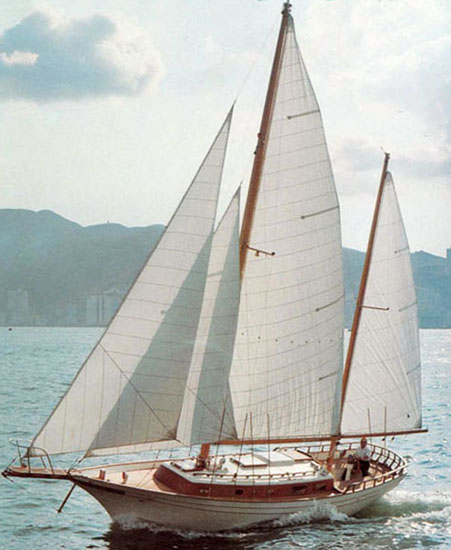
Clipper 36 cheoy lee for sale elsewhere on the web:

Main features
Login or register to personnalize this screen.
You will be able to pin external links of your choice.

See how Sailboatlab works in video

We help you build your own hydraulic steering system - Lecomble & Schmitt
Accommodations
Builder data, other photos.
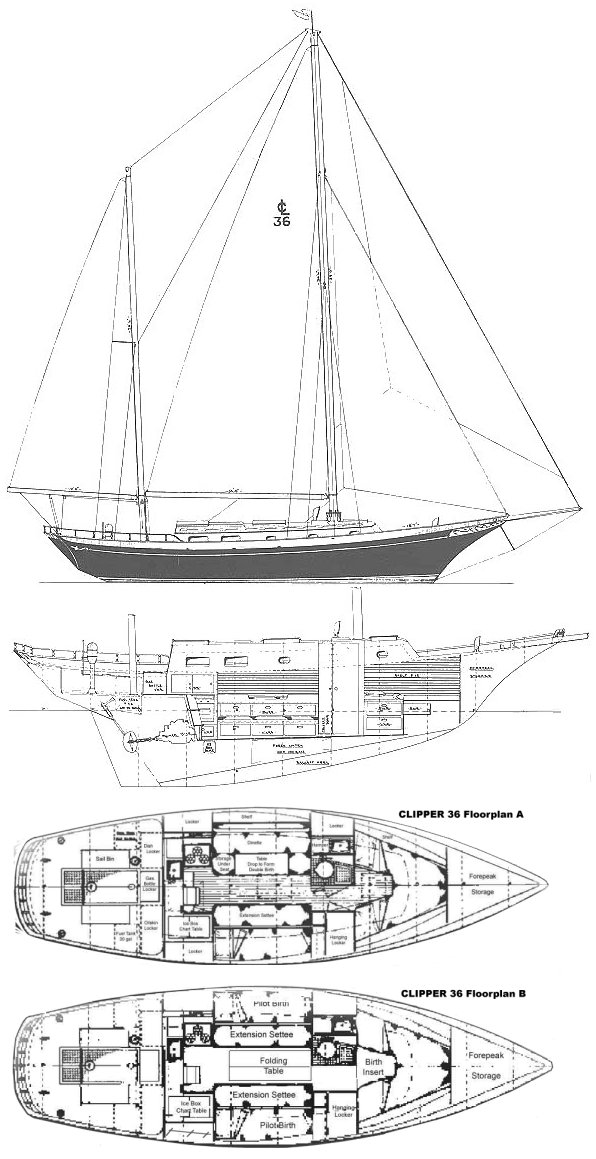
Modal Title
The content of your modal.
Personalize your sailboat data sheet

IMAGES
VIDEO
COMMENTS
Cheoy Lee Shipyard Ltd.(HK) Designer: A. E. Luders: KLSC Leaderboard. Auxiliary Power/Tanks (orig. equip.) ... 36.30 ft / 11.06 m: E: ... to the bottom of the keel or fin. Like the LWL, it will vary with the weights of fuel, water, stores and equipment. A boat's actual draft is usually somewhat more than the original designed or advertised ...
1970 Cheoy Lee Luders 36. US$29,500. Yachtfinders Windseakers | San Diego, California. Request Info. <. 1. >. * Price displayed is based on today's currency conversion rate of the listed sales price. Boats Group does not guarantee the accuracy of conversion rates and rates may differ than those provided by financial institutions at the time of ...
BACKGROUND The Cheoy Lee Clippers were designed in four lengths (33, 36, 42 and 48 feet) by Bill Luders and built by the Cheoy Lee shipyard on the Pearl River in Hong Kong. Built between 1968 and 1988, the Clippers caught the wave of sailboat cruising that swept America, and the design's salty, retro, wood-highlighted look helped.
Find Cheoy Lee boats for sale in your area & across the world on YachtWorld. Offering the best selection of Cheoy Lee boats to choose from. ... Fort Lauderdale, Florida. Request Info; 1969 Cheoy Lee Offshore 27 Cadet. ... 1963 Cheoy Lee 36. US$41,900. ↓ Price Drop. St. Clair Sailboat Center | Saint Clair Shores, Michigan. Request Info;
Cheoy Lee Pedrick 36. Rock Hall, Maryland. 1985. $39,900. If you are a boat enthusiast looking for a unique vessel, with beautiful lines, than the Odyssey II is the boat you have been looking for. Built in the Cheoy Lee Shipyard and designed by David Pedrick, the boat was first built in 1985. It has a hull type of Fin with rudder on skeg and ...
Find Cheoy Lee 36' boats for sale in your area & across the world on YachtWorld. Offering the best selection of Cheoy Lee boats to choose from.
Cheoy Lee Luders 36 is a 35′ 5″ / 10.8 m monohull sailboat designed by Alfred E. Luders and built by Cheoy Lee Shipyard between 1966 and 1978. ... The lower a boat's ratio is, the less power it takes to drive the boat to its nominal hull speed or beyond. Read more. Formula. D/L = (D ÷ 2240) ÷ (0.01 x LWL)³ D: Displacement of the boat in ...
The Luders 36 cheoy lee is a 35.5ft masthead sloop designed by A. E. Luders and built in fiberglass by Cheoy Lee Shipyard between 1966 and 1978. 65 units have been built. The Luders 36 cheoy lee is a very heavy sailboat which is slightly under powered. It is stable / stiff and has an excellent righting capability if capsized.
Built with the help of family and friends over a 3 years, in a friends garage the boat was launched in 1962. It quickly became the boat to beat and the boat that attracted the best of the best in local sailing. It's design was sold to Cheoy Lee Yachts and was manufactured as the Offshore 36 for the next 10 year, with a 1000 hulls being sold.
The Cheoy Lee Clipper 36 was built from 1969 to about 1988. The Clipper 42 was introduced in 1970. Eventually, both were replaced by the more contemporary designs of David Pedrick. We doubt that very many Clipper series boats were brought into the U.S. after the mid- or late 1980s.
cheoy lee preowned sailboats for sale by owner. cheoy lee used sailboats for sale by owner. Home. Register & Post. View All Sailboats. Search. Avoid Fraud. ... Cheoy Lee 36 Offshore: Length: 36' Beam: 10' Draft: 4'6' Year: 1966: Type: cruiser: Hull: ... Fort Lauderdale, Florida Asking $42,500. 39' CE Ryder Southern Cross 39 Seward, Alaska
Cheoy Lee Midshipman 36 is a 35′ 9″ / 10.9 m monohull sailboat designed by Alfred E. Luders and built by Cheoy Lee Shipyard starting in 1973. ... The lower a boat's ratio is, the less power it takes to drive the boat to its nominal hull speed or beyond. Read more. Formula. D/L = (D ÷ 2240) ÷ (0.01 x LWL)³ D: Displacement of the boat ...
1964 36' Cheoy Lee Offshore 36 sailboat for sale in San Rafael California
A Ballast/Displacement ratio of 40 or more translates into a stiffer, more powerful boat that will be better able to stand up to the wind. Bal./Disp = ballast (lbs)/ displacement (lbs)*100 Disp./Len.: The lower a boat's Displacement/Length (LWL) ratio, the less power it takes to drive the boat to its nominal hull speed. less than 100 ...
Find Cheoy Lee 36 boats for sale in North America. Offering the best selection of Cheoy Lee boats to choose from. ... 43 ft. Model-cheoy-lee-desktop. 48 Center Cockpit. Model-cheoy-lee-desktop. 53 MS. Model-cheoy-lee-desktop. 66 Fast Motor Yacht.
Cheoy Lee Luder's 36. Greetings All! It has been a few years since I tailed a wench, in most of the meanings you might take from that. It is time, again, to take to the water and I have just acquired a 36 foot 1974 Cheoy Lee, Luders design, sloop rigged. The boat is on the hard with mast and rigging down so I will take a couple of weeks to ...
length overall (LOA): 36. year manufactured: 1988. Newly rebuilt Cheoy Lee sailboat with 6' draft and 11.5' beam. It has: smooth running 32hp universal 5432 engine. 50 gallon diesel tank. 2 brand new deep cycle house batteries and 1 new starting battery. 16,000 BTU AC unit. working 12v DC fridge/freezer.
MIDSHIPMAN 36 (CHEOY LEE) Save to Favorites . Beta Marine. BOTH. US IMPERIAL. METRIC. ... Cheoy Lee Shipyard: Download Boat Record: Notes. Available as sloop or ketch. Sailboat Forum. View All Topics: ... CSF = Beam/Disp (cubic ft)^.333. The displacement in cubic feet can be found by dividing the displacement in pounds by 64.
The Clipper 36 cheoy lee is a 35.63ft staysail ketch designed by A. E. Luders and built in fiberglass by Cheoy Lee Shipyard between 1969 and 1988. 60 units have been built. The Clipper 36 cheoy lee is a very heavy sailboat which is slightly under powered. It is reasonably stable / stiff and has an excellent righting capability if capsized.
San Diego United States $29,500 USD. The 1970 36' CHEOY LEE Luders 36 Cruising Sailboat Westwind is a sail boat for sale located in San Diego, California, United States. Contact the yacht broker to receive more information or schedule a showing of this 1970 36' CHEOY LEE Luders 36 Cruising Sailboat Westwind yacht for sale in San Diego ...
1971 36' Cheoy Lee Ludders 36 sailboat for sale in Ft myers Florida. Home. Register & Post. View All Sailboats ... Beam. Draft. Location. Price. 1971. 36' 13' 6' Florida. $18,000. Description: 1971 Cheoy Lee Ludders 36 Letting this Ludder 36 go, started to give her a facelift, but found my dream boat! Had a huge refit and featured in goodolboat ...
Offering the best selection of Cheoy Lee boats to choose from. ... Fort Lauderdale, Florida. Request Info; Price Drop; 1979 Cheoy Lee C and L Explorer ketch ... ↓ Price Drop. Holland Yacht Sales | Macatawa, Michigan. Request Info; Price Drop; 1963 Cheoy Lee 36. US$41,900. ↓ Price Drop. St. Clair Sailboat Center | Saint Clair Shores ...
Contact. 416-639-1182. Cheoy Lee Clipper 48. Jersey City, New Jersey. 1976. $199,000. King Loon is a beautiful boat built in the Cheoy Lee tradition and then rebuilt from the hull on up by the current owner in the last 8 years. This is the classic blue water world traveling yacht.